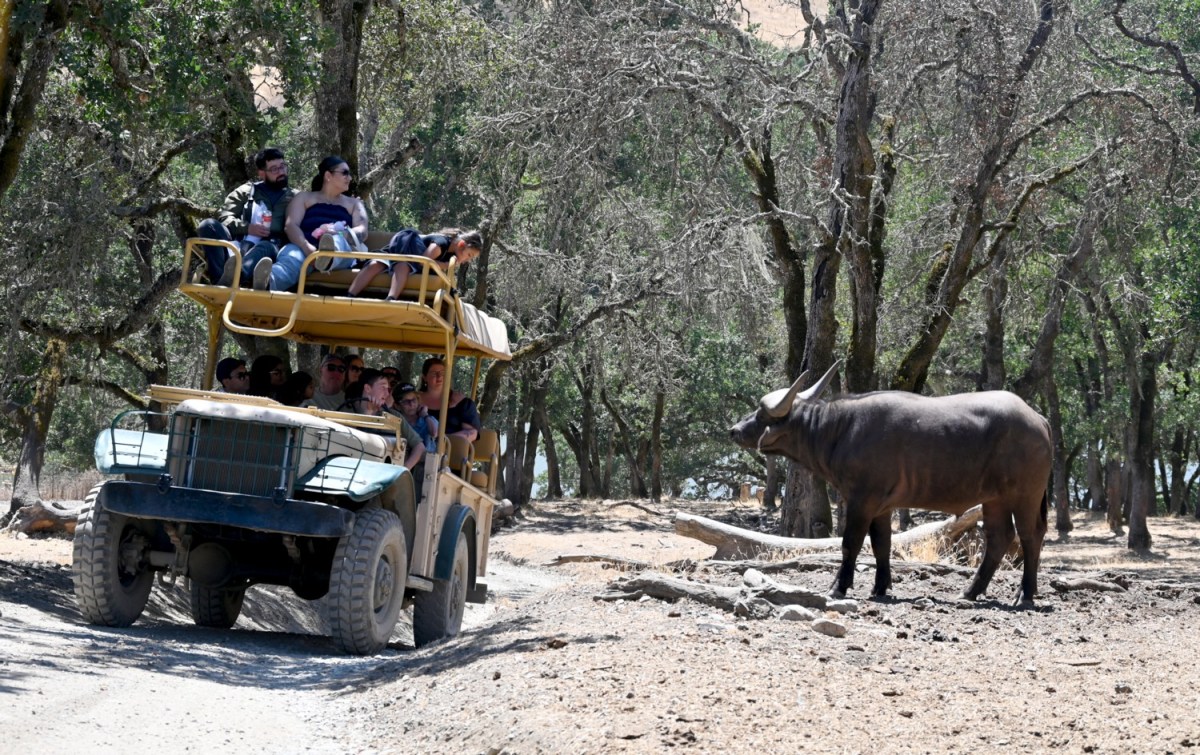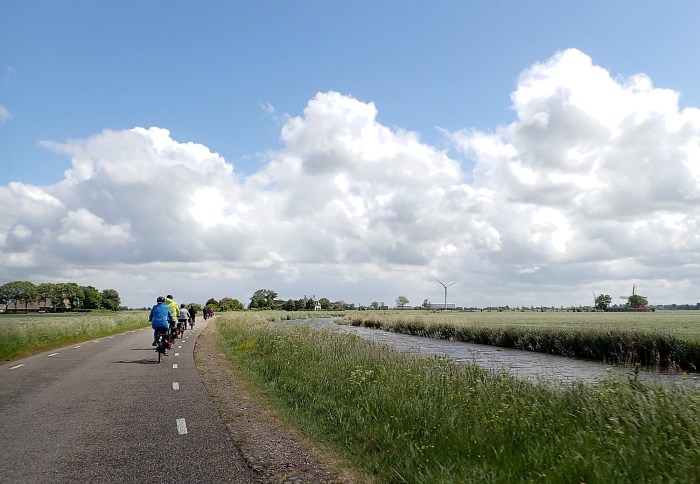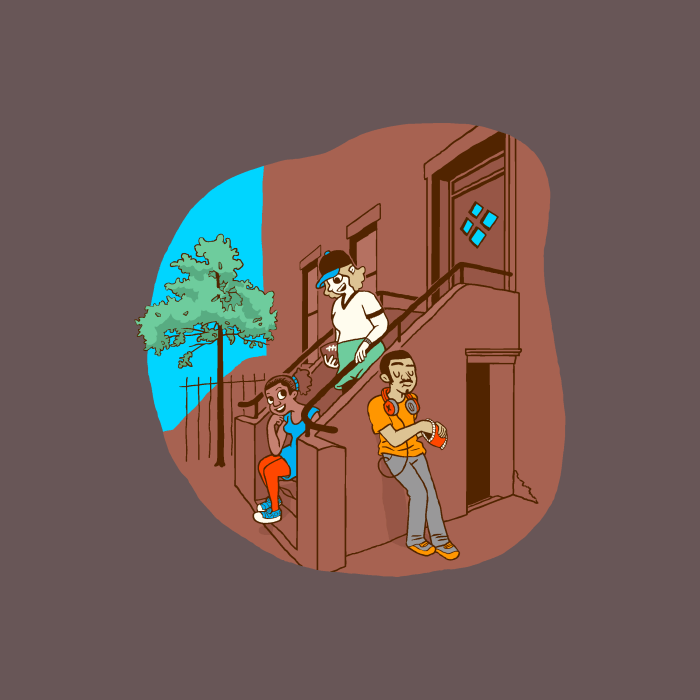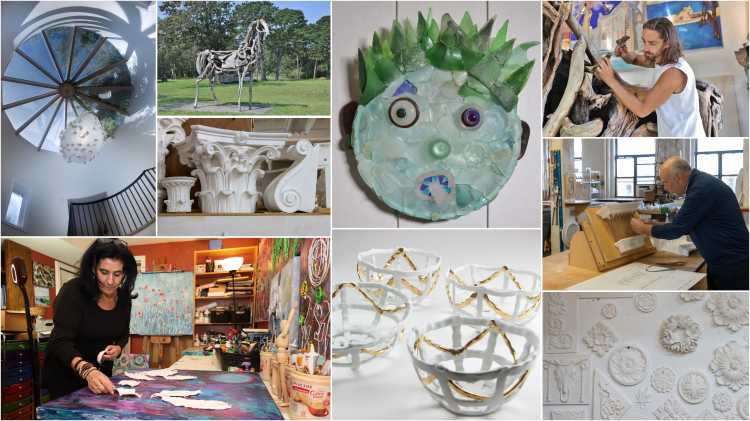By Karen Rubin, Travel Features Syndicate, goingplacesfarandnear.com
It isn’t a surprise to see zebras grazing, giraffes ruminating, a rhinoceros with her 2700-pound baby, or sleeping in a luxurious safari tent and awakening to see a herd of antelope dashing in unison, when you go on safari in Africa. What is extraordinary is that this is in the backyard of Sonoma, California, better known for wineries, vineyards and winetasting. This is Safari West, which since its founding in 1993, affords an extraordinary authentic experience that makes you feel you are in Africa – the Sonoma Serengeti! – no passport, vaccinations or jetlag required.
Eric and I start our Safari West visit with the three-hour Classic Safari, consisting of about 2 ½ hours driving through three habitats across the vast, 400-acre landscape on which some 1000 animals (almost 100 different species), reside and a half-hour walk to visit mammals and birds.

During the course of my 24 hours here, I will follow the Classic Safari with a Behind-the-Scenes tour with our toddler (children need to be at least four years old for the Classic Safari, though families with younger children can arrange a Private Safari) where we get to feed a variety of animals; a 5 pm buffet dinner, followed by a walk-about through a zoo-like setting.

Then, after the rest of the family leaves, I stay over for a Glamping Among the Wildlife: A Safari West Experience in one of their 30 authentic Botswana safari tents tucked into the trees, enjoying evening activities including s’mores and a movie (“Jungle Book”). Since overnight guests have no curfew, I am able to explore more at dusk, into the dark of night (borrowing a flashlight from reception), and again in the early morning when the animals are most animated. I follow the included breakfast buffet with more exploration before reluctantly leaving Safari West.

Safari on the “Sonoma Serengeti”
For our Classic Safari, we ride in vehicles that are open on the sides and have four seats on top (reminding me of my tiger safari in India). The guides – invariably friendly, humorous, knowledgeable and unscripted so they respond to their guests’ interests (and terrific drivers) take us on rough gravel trails over hills and plains, coming incredibly close (without barriers or fences) to giraffe, antelope, ostrich, wildebeest, Cape buffalo, zebra, elands, addax, aoudad and others among the 97 species in residence.
Our guide for our 1 pm. three-hour Classic Safari, Alex Killian, invites our questions and observations which she gleans to stay in an area longer. We are riding in “Bender”, a 1950s Dodge Power wagon (it seems Safari West has bought up the fleet of Dodge Power wagons from 1940s to 1970s). About 2 ½ hours are spent driving, with about 30 minutes on a walking portion to see the primates, porcupines and birds.
You can read about these different animals and see photos but seeing them up close, in their habitat provides a whole different dimension of understanding and appreciation for behaviors and evolutionary adaptations.

We go into the vast field with the giraffes– Killian tells us they are 5-6 feet tall at birth (they are delivered while the mother is standing up and are dropped six feet to the ground); 9 feet tall by one year old, and grow up to 19 feet tall. These sweet creatures – literally gentle giants – are distinguished by the fact every giraffe has a unique pattern of sports, like human fingerprints, but these spots also help in thermoregulation (at night, the giraffes walk themselves into their barn to protect from hypothermia).
Giraffes, Killian says, “speak” but in a pitch that can barely be heard by a human but sounds like a moo and use various sounds like moans, snores, hisses, and grunts, they mainly communicate with body language. Killian tells us they sleep standing up for 20 minutes at a time– only half their brain sleeps at one time – for a total of about two to three hours in the course of a day; the rest of the time they are eating or ruminating. (Later, during the Behind-the-Scenes tour, we get to meet them close up and feed them).
Killian points to “Mango,” the only male giraffe, here, noting that the animals mate and breed naturally here; the caretakers only insuring they are healthy, and adds that Safari West will “buy, sell, trade, borrow and loan” animals with other zoos and conservancies to increase genetic diversity.

In this plain, we also see Dama Gazelle; Gemsbok; Greater Kudu; Roan antelope and Addax, astonished at how magnificent they are with their horns and coloring.
Leaving this area through the double-fence system, we see an ostrich which seems to be “flirting” with the safari vehicle ahead of us. This is “Lucille Ball,” “She is more flirtatious when she is about to lay an egg,” Killian explains. Ostriches, Killian tells us, lay the largest eggs among the birds, equivalent to 12-24 chicken eggs in size and lay 1-3 eggs a week.
Ostriches are surprisingly large and amazingly fast – she tells us they can run 12-35 mph and though they have a brain the size of a walnut, “they are not dumb.” “It’s an ‘in the moment’ animal,” she explains. “But you don’t need to outwit a predator when you can outrun it.”
We see a Southern White Rhinoceros mom with her two-year old baby that already weighs 2375 lbs. She is pregnant again (rhinoceros gestate for 16-18 months) and is due to deliver at any time (you can follow her progress on social media). But because the pheromones at the end of pregnancy and when she is in labor are the same as when she is in heat, they have to separate the male, who is in an adjacent area. In the wild, she says, “They spend a week together and then don’t see each other again” but the mom is very maternal. “She is very connected to her baby.” She can nurse two babies at a time. The female rhinoceros can weigh 4000-7000 lbs. A herbivore, the rhinoceros consumes 150 lbs of grass or 60 lbs of hay a day.

We drive through more gates and come to an open area with zebra gathered around where they have just been provided grass. Like the giraffes, the zebra’s stripes are unique from zebra to zebra and even left and right sides of the animal, except for its face.
Close by are the Common Eland and we see a baby less than one month old (it’s been named “Nova”, consistent with the space-themed names given the herd). The Eland (“it means ‘moose’ in Dutch) is a kind of antelope, the biggest of the species (the tallest is the Kudu).
“They depend largely on pheromones – it’s how they identify the others in their unit, and how they take a mate. They urinate and others take in the pheromone.”
We drive into the third habitat, the largest of the three at 100 acres.
We see the African Cape Buffalo, one of the Big 5 – that is, the 5 most dangerous animals to encounter in Africa, she tells us (lion, leopard, Black rhinoceros, African Bull elephant are the others). The Cape Buffalo are dangerous, she says, because they protect each other. “If one of their group is threatened, even if they just think it is threatened, they will still protect.”
We meet the Blue wildebeest from Southern Africa which Killian calls “a spare parts animal” because it has hair and horns resembling the female African Cape buffalo; stripes like a zebra; a long face like a baboon; and a heavy build in front but slender legs like an ostrich compared to its bulky front build.

These are adaptations to the environment, and as we watch one nuzzling a baby, Killian tells us that its long face helps the wildebeest detect humidity – and impending disaster, and that the herd in the wild, 1-5 million of them, migrate or escape danger moving together. Other animals have learned to follow their lead.
In the wild, they somehow synchronize the births to the month, timed for migration. Some 8,000 babies could have been born on the last day before migration, so wildebeest have evolved to move as fast as 55 mph, from Day 1. Here at Safari West, they somehow synchronize births to the season (rather than a month, as they might in the wild) and ‘migrate’ on property (moving down the hillside).

“Animals here mate naturally,” she adds. “We only make sure they are healthy.”
We spot Aoudad on the forested slope, and Killian says that while other species take a mate by showing dominance (brawn), Aoudad males pee on their beard and the ‘best’ smell gets the lady.
(Insiders tip: if photography is important to you, bring a decent SLR camera with a decent zoom lens that can capture moments and movements (cell phone cameras are good for scenics and landscapes and have their merit in difficult lighting situations). Safari photography is just as interesting a sport as hunting – only you are hunting and shooting with a camera. For avid photographers, Safari West offers a Private Photography Safari Workshop.)
After the drive portion of the Classic Safari tour, we have a walking tour of about 30 minutes, to see the porcupines, primates, mammals and birds.
We walk through one of the aviaries, chock full of bird varieties – crane, sacred ibis, scarlet ibis, spoon bill, cattle egret, black swan, Nicobar pigeon, to list but a few. (We will soon return to help feed the birds during our Behind the Scenes tour).
We see the Caracal, a master of hunting and hiding that can jump 6-10 ft to capture a bird, take down prey 2-3x its size and when they hunt as a group, they can take down an impala.

I especially love watching the Colobus Monkey and the Patas Monkey (said to have been the inspiration for Dr. Seuss’ Lorax), ring-tailed lemurs (two “old men” in their bachelor pads), and (my favorite) the Red Ruffed Ringtales. All have various forms of enrichment – like puzzles and toys, obstacles and constructions. (There is an immersive Enrichment Tour, also on my list for my next visit.)
Behind-the-Scenes
Our Classic Safari ends just in time to meet up with Sarah and our 16-month old toddler to enjoy the Behind the Scenes tour where we get to feed the animals – one of Safari West’s most popular programs for good reason.
Our guide, Zoey, tells us she was part of Safari West’s Junior Zookeepers program for 12-16 year olds.

Even our toddler gets a chance to feed the Crested porcupines, Spike and Norton – notably, they don’t have the prickly quills, their quills are a softer material.

We go next to feed the birds in the aviary and Zoey warns us that it can be intimidating because there are so many birds and they get pushy when they see the blue latex glove and know there is food to be had. She adds that to stop the birds from rushing at you, take off the blue glove. I find it fascinating that there is such a learned behavior.
Sure enough, it is quite an experience that as we walk in, the birds swarm around us. We get to fling pieces of chopmeat (that surprises me) and watch as the biggest ones catch pieces in the air.

We go to where there is a huge flock of flamingoes in a small pond. These, Zoey says, are the oldest animals at Safari, many came when Marine World closed in 1969. They can live to 30 years old in the wild, but can reach 60-70 years in captivity (the oldest known is 85).
We next go to the Giraffe Barn to feed “Mabel.” Coming so close to the giraffe is truly an experience.

With eating being the giraffes’ main activity, their tongues are the most distinctive feature – they can be up to 18 inches long and are prehensile to grasp and manipulate objects, so they can strip leaves from branches and maneuver around thorns and rugged bark to reach their food. Also, the front of their tongues are dark, with melanin, to protect from sunburn. They eat the leaves but leave the roots, so that their food source will renew. During the course of a day, they will consume 100 lbs of foliage.
The giraffes come when the keeper calls them to go into barn overnight, to prevent hypothermia
We finish our Behind-the-Scenes tour by feeding the warthogs “Lucy”, Vigeri and Fig Newton
And now it is time for our feeding.
Dining Out, Staying Over
Safari West offers a fixed menu buffet dinner (two seatings, at 5 and 7 pm) which is marvelous.
The meal is superb – chicken (paprika seasoning), steak (perfectly cooked over fire), rice, mac/cheese, salad (we are invited to have seconds until they run out), fresh fruit and a cheesecake dessert.
Guests who stay for dinner can wander the property until 8:30 pm; overnight guests (like me) can wander without any curfew.
(There is also a very pleasant deli where you can pick up sandwiches and such (good selection and very reasonable cost.)
Even when I go around at 7:30 pm when the sunlight is a rich golden color – I am surprised that it seems as if the animals have grabbed their coats and lunch buckets for quitting time (the porcupines are curled up), but several are very active.

The three Red Ruffed Lemurs, with stunning, fluffy red fur, black faces and bright, piercing yellow eyes, are really active at this time. Earlier in the afternoon, when I came upon them, they were making extremely loud shrieks – indeed, the guide says they are the second loudest primates and can vocalize very high and low pitches at the same time, that can be heard up to a half-mile away. Found only in Madagascar, they are matriarchal and the keeper explains that one of the three is being bullied, kept from being groomed and from eating,
There are S’mores at 8 pm and then they show “Jungle Book” (one of three animal-themed movies they present each night) at 8:30 pm. (Overnight guests can help ourselves to coffee, tea, chocolate an fruit as we like

After the movie, I borrow a flashlight from the reception desk, and go into the darkness. I am especially interested to see if I can observe activities of nocturnal animals, but alas, it is too dark and the animals, if they are active, are too far into the darkness to be observed (perhaps on a night with a full moon it would be better and even more magical.)
By now pitch black (and grateful for the flashlight), I walk up the hill to my tent, delighted to find a luxurious, spacious room accommodating a queen bed and two cots, sufficient for a family of four, with beautiful wood floor, an enormous tile-floor bathroom stocked with the necessary toiletries like a deluxe hotel; giant screened windows on two of the walls so I can see out to a gorgeous view of the lake; and a patio where, when I walk out in the pitch black night, it seems the Big Dipper is right in front of my face close enough to touch. If it gets cold, there is a space heater and an electric blanket.

I am surprised that I do not hear more animal sounds in the night, and do not need to use the ear plugs they supply.
But I awake to the sounds of birds and mooing, and look out from my porch to see the herd of antelope running together across their field.

The best part of overnighting at Safari West is being here at early morning when the animals become really active knowing they are to be fed.


Each place i come upon, if there is a keeper, they are happy to share more information about the animals in their care.

I watch the Red Ruffed lemur being fed – one is being bullied by the matriarch, so the keeper goes in, entices two of them into a separate compartment, and gives the third special attention (she doesn’t get groomed, so the keeper pats her and feels for any health issues).


I get to see the cheetahs, pacing their enormous enclosure (they eluded me the previous day); and the hyenas devouring a thick chunk of red meat
As appropriate, the keepers incorporate enrichment into their feeding methods so the animals have to work for food. (“Most creatures are bribable with food,” our guide Killian had told us on the Classic Safari. “Food is a prime motivator.” (Safari West offers a new Enrichment Tour Experience to see how they use puzzles, toys and activities like hiding treats, to stimulate the animals’ natural behaviors and keep them mentally and physically active.)

I go into the Elephant room for breakfast (included for overnight guests and served from 7-10 am) – eggs, oatmeal, cereals, yogurt, muffins, toast/bagels, fresh squeezed OJ – before going for another walk-through the animal enclosures.
As an overnight guest I need to be out of the tent by 11, but I am welcomed to stay and wander about as long as I want.
Overall, with all these encounters over the past 24 hours, I must have made some 10 tours through the animal enclosures and each time, the experience is different – I see animals that eluded me before, or doing different behaviors, or in different light, or just happening upon a guide providing information I hadn’t known before.
Mission to Promote Conservation
I am really impressed in how well Safari West fulfills its declared mission to actively promote conservation and environmental education.
“At Safari West it’s all about the animals. Always has been, always will be.” These animals become ambassadors for their species, promoting understanding and appreciation to help each person make well-informed choices for environmental protection and wildlife conservation.
Over the past decades, Safari West has evolved into a top-tier wildlife destination.
Safari West began in the late 1980s when Peter Lang purchased 400 rolling acres in the foothills of the Mayacamas Mountains. He relocated his small but growing collection of exotic wildlife, converting a former cattle ranch into a world-class conservation breeding facility.
As Peter set to work establishing captive breeding programs for the varied and often critically endangered species in his collection, he worked closely with local zoological facilities including the San Francisco Zoo where he met the lead curator, raptor-specialist and his future wife, Nancy Lang. After four years of operating their conservation breeding facility behind closed doors, Peter and Nancy opened their home to the public on July 4th, 1993.

Then, in the late 1990s, Peter looked to expand the activities available to guests and built the Safari West Tent Camp, importing custom-built tents from Lobatswe, Botswana. With the Watusi Pond as the center, the tent camp sits between the Gazelle Pasture, the Hundred Acres, and the Vista habitats, overlooking the antelope and giraffes. The 30 glamping tents are mounted on raised platforms, with hardwood floors, electricity, running hot and cold water, and even en suite bathrooms.
The Langs’ devotion to their animals was tested and proven during the horrific Tubbs wildfires that struck in October 2017.
When I ask our safari guide about how they managed during the wildfires, she replied, “We didn’t save the animals, they saved us. They graze so there was nothing for the fires to catch onto, and the oak trees are resilient.”
She relates that when sheriffs came to order an evacuation at around 11 pm, the 90 guests on the property just grabbed their keys and left within 15 minutes.” Helicopters fighting the fires used water from the lake.
But she seems to have understated what happened because it was horrific – 250 out of Safari West’s 400 acres were scorched and the osteology lab operated by the Safari West Research, Education, and Conservation Department burned completely. Though conservation organizations were ready to help evacuate the animals, no one was allowed up the twisting mountain road, so they couldn’t have evacuated the animals.
The animals were saved because Safari West owner Peter Lang, then 76 years old, after driving through fire to evacuate their home which burned to the ground, stayed behind and for the next 10 hours, fought the fires alone. In the next couple of days, some volunteers and staff were able to come and help put out the brush fires that erupted.
All 1000 animals were saved. For his heroic efforts, Peter Lang received the 2018 American Red Cross Animal Rescue Hero Award. (Read the thrilling story by Paige Peterson reported in the New York Social Diary, https://safariwest.com/2017/11/life-after-fires/).
Safari West is ideal for family gatherings and special events – I am already planning to bring our bi-coastal family together for an overnight stay as soon as the little ones are old enough to appreciate the safari. I’ve earmarked the Enrichment Tour and Private Photography tour, especially.
Safari West, 3115 Porter Creek Road Santa Rosa, CA 95404, 800-616-2695, 707-579-2551, safariwest.com.
Travel planning help is available from Sonoma County Tourism, https://www.sonomacounty.com
_____________________________
© 2025 Travel Features Syndicate, a division of Workstyles, Inc. All rights reserved. Visit goingplacesfarandnear.com and travelwritersmagazine.com/TravelFeaturesSyndicate/. Blogging at goingplacesnearandfar.wordpress.com and moralcompasstravel.info. Visit instagram.com/going_places_far_and_near and instagram.com/bigbackpacktraveler/ Send comments or questions to FamTravLtr@aol.com. Bluesky: @newsphotosfeatures.bsky.social X: @TravelFeatures Threads: @news_and_photo_feature



















































